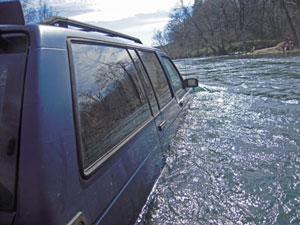Anyone considering the purchase of a used vehicle should certainly take a test drive before closing the deal, but a recent incident at the Buffalo National River confirmed that "prudence is a virtue" only if prudence has a vote in the way that test drive is to be conducted.
On April 6, 2013, an off-duty District Ranger/Swiftwater Technician was contacted by visitors with a classic "Hey Ranger, better go check on this" situation.
According to the visitors, an SUV was partially submerged in the Buffalo River at the Mt. Hersey Campground, and it was not known if anyone was in the vehicle or in immediate danger.
The District Ranger notified park dispatch and headed to the campground, where he observed a 1992 Chevy Blazer in the middle of the river, facing upstream, with the entire lower half of its body submerged in very swift, cold current. He donned swiftwater personal protective equipment to aid in swimming and/or wading to the vehicle, conducted a quick risk analysis, determined the operation to be well within guidelines and called for a wrecker.
A second Ranger/Swiftwater Technician arrived on-scene within a few minutes and provided downstream throwbag safety while the District Ranger made his way to the vehicle. He determined that no one was in, around or under the vehicle, and attached the tow cable from the wrecker.
The SUV was pulled out of the river without incident. There were, however, no answers to the usual "who" and "why" questions, so the vehicle was impounded until the identity of the driver and/or the owner could be determined.

Not the view you want from your SUV. NPS photo.
The ranger's investigation revealed that a brother and sister had borrowed the vehicle from an associate to 'test the four-wheel drive' prior to a possible purchase. Their idea of a really good test was to attempt a crossing of the four-foot-deep river, which at the time was flowing at a hefty 1,100 cubic feet per second.
Violations Notices were issued to the driver of the Blazer for careless operation, leaving the scene of an accident, and creating a hazardous condition.
There was also an additional piece of information at the scene that might help explain why anyone would attempt this stunt in the first place. After being questioned about the eight empty beer cans floating in 'passenger compartment eddies' in the vehicle's interior, the passenger was issued a Violation Notice for possession of an open container of an alcoholic beverage.
There was no word on the final outcome of negotiations for the purchase of the vehicle.




Comments
What a hoot! Another cautionary tale for those who "challenge nature" with motors instead of personal mobility...
They must have thought it was a Ford Explorer. I'll see myself out.
Thanks, Lost Heritage, for a morning chuckle, and to Jim for the story.
Eye roll.